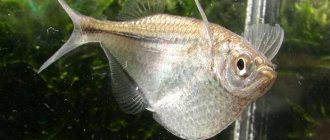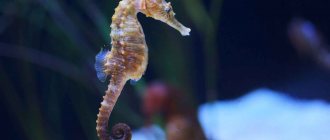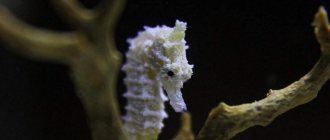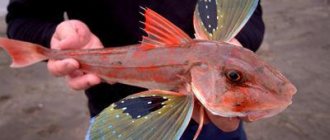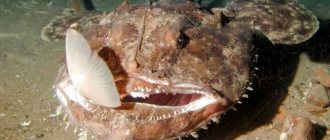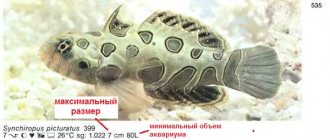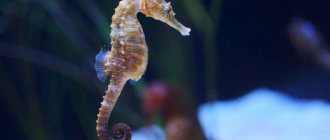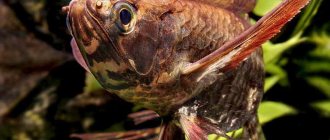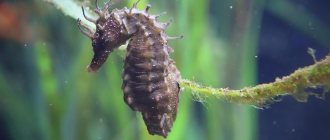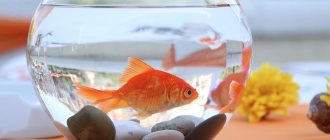Habitat in nature
Monodactylus argentus or Argentus was first described by Linnaeus in 1758. Monodactyls are very widespread throughout the world.
They are found in the Red Sea, off the coast of Australia, Africa, and throughout Southeast Asia. The silverfish in nature lives in schools near the shore, in reefs and in places where rivers flow into the sea.
Adults inhabit coastal areas, while juveniles stay in less saline waters. In the wild, they eat a variety of plants, detritus and insects.
Content complexity
Monodactyls are fish that live in brackish water. They are large, brightly colored and quite popular.
Almost every brackish water aquarium has at least one species of monodactyl.
Silver is no exception; it grows up to 15 cm, and must be kept in a flock. Singles are too timid and do not live long.
If you keep them correctly, the flock will delight you for many years. But, only experienced aquarists should start them, since as they grow older they need to be transferred from fresh water to salt water.
Sexually mature ones can even live in a saltwater aquarium. If this does not scare you, then otherwise it is an unpretentious fish that eats all types of food.
Features of behavior
In nature, monodactyls live in packs; in the aquarium they also demonstrate collective behavior. They tirelessly rush around the aquarium, performing a synchronized, mesmerizing dance.
In a school of monodactyls, the largest fish dominates the rest. Clear signs of a hierarchy can be observed during feeding - the dominant fish pounces on the food first. Experienced aquarists advise keeping monodactylus in groups of 6-8 pieces.
Alone and when kept in pairs or even threes, the fish may display aggressiveness of the dominant fish - both towards its relatives and towards representatives of other species. And swallows, when they lack “company,” become timid and hide in shelters.
Fish also show timidity when moving to a new place of residence. Frightened swallows often rush around the aquarium so quickly that it is almost impossible to catch them even in an empty tank.
Description
The body shape of the Argentus is its distinctive feature. Tall, diamond-shaped, it somewhat resembles a freshwater angelfish.
In nature it grows very large, up to 27 cm, but in an aquarium it is much smaller and rarely exceeds 15 cm. It can live for about 7-10 years.
The body color is silver with yellow coloring on the dorsal, anal and caudal fins.
He also has two vertical black stripes, one running through his eyes and the other trailing behind him. Also, the black edging extends to the edge of the anal and dorsal fins.
Sea damselfish, rockfish, bops, silverside and other trash fish in the Aegean Sea
Surprisingly, people who have lived on the Black Sea coast all their lives do not suspect that such a very unpretentious and completely unsuitable for food fish as the sea swallow or chromis (Chromis chromis LINNAEUS, 1758) can live in this water basin. During my vacation on the Black Sea coast of the Caucasus, I occasionally asked if those fishing had caught a hook on a small tailed sea swallow. Almost everyone answered my question in the negative. The most striking thing is that the sea swallow also does not particularly want to get into poachers’ fine-mesh nets installed in rocky shallow waters in the Black Sea and its captures are completely random. A completely different “song” is happening in the Mediterranean Sea.
On this coast, indented by small bays and with high rocky ledges, at a depth of 1.5 meters, the sea swallow (Chromis chromis LINNAEUS, 1758) is the sole owner, grouping in flocks of 10-30 individuals, and sometimes more. To complete the impression, I present below a video made on the Black Sea, where chromis appears in all its pristine glory.
Sea swallow. Fishes of the Black Sea
I would also like to give a brief description of this extremely disgusting creature that lives in the Mediterranean basin and has poisoned the lives of many generations of amateur fishermen. Chromis or greenfin or swallow or nun or green fish (scientific name in Latin Chromis chromis) is a species of ray-finned fish of the extensive family Pomacentridae, well known to readers who vacationed on the Red Sea. In European colloquial language it is often called damselfish (girl fish) or Mediterranean chromis (Mediterranean chromis).
The body length of this fish does not exceed 13 cm, height - 2.1-2.5 cm. The body color of adults is chestnut-brown, while juveniles are bright blue. The caudal fin is forked, elongated. This species of the Pomacentraceae family lives both in the Mediterranean basin (including the Black Sea) and in the eastern Atlantic at a depth of 2 to 40 meters. The sea damselfish or chromis lives in small flocks over reef rocks and in coastal thickets of phyllophora or cystoseira. It feeds on small planktonic and benthic organisms, as well as periphyton (this is a set of organisms that settle on underwater objects or plants and form so-called fouling on natural or artificial hard surfaces - stones, cliffs, underwater parts of ships, piles, hydraulic structures - algae, barnacles, mollusks, bryozoans, sponges, etc.). I would like to emphasize that the sea swallow (Chromis chromis LINNAEUS, 1758), living in the Mediterranean Sea basin, is active from 6 a.m. until approximately 5:30-6:30 p.m. Then this fish hides in rocky crevices at the bottom and is practically half asleep all night. I ask everyone reading these lines to take into account this feature of this trash fish. Some popular scientific sources indicate that the sea swallow (Chromis chromis LINNAEUS, 1758) is quite edible and even tasty after certain types of heat treatment. I can’t imagine how someone who caught this fish, no larger than 10 cm in size, would struggle to clean it and even eat it. An amazing thing: once I had to fish in Icmeler using a Chinese-made “Smoktun” (“Spring”) tackle (read about this tackle HERE https://delvaneo.ru/fishing/mugil/kombinirovannyj-montazh-pri-lovle -kefali.html). True, I slightly improved this tackle by attaching a massive foam plastic float to the leash instead of a lead sinker, which allowed the bread ball to hang in the water column at a distance of 30-40 cm from the surface. Having thrown a ball of bread, hung like a Christmas tree with six hooks stuck pointing up, 20 meters from the shore, a minute later I discovered that a school of small fish had appeared around this tackle, plucking the bait with unprecedented frenzy. Having pulled the tackle to the shore, no more than 3 meters, I had to see sea swallows (Chromis chromis LINNAEUS, 1758), no less than 30 individuals, actively plucking bread from under the hooks, without being detected. A couple of minutes later, a fat Turk ran up to me with a huge landing net and showed with signs that he wanted to pull the whole school ashore. And so it happened, the Turk skillfully inserted a landing net under the Smoktun tackle, and a moment later pulled almost the entire school of sea swallows to the shore. I don’t know what I started doing with these small fry, but I remember the fact of the sudden appearance of a school of chromis at the bait very well. And indeed, all three weeks of my stay in Icmeler, everywhere: in the port, on a wild rocky beach, in Marmaris on the city embankment, in Armutalan on the pretentious beach of the MARMARIS PARK hotel and near a deserted island (I fished from a longboat, at a depth of about 8 meters ) – sea swallows relentlessly pursued me as a necessary attribute of amateur fishing in the Aegean Sea.
One day I was lucky enough to go on an excursion to the islands of the Aegean Sea. There were only 15 people on the longboat, of which me and a young Briton tried to catch something both by trolling and using a regular donkey with three hooks. The Englishman, having torn off about four oysters in shallow water, “loaded” the donk and, throwing out the tackle (they were fishing without a rod, with a fishing line wound on a reel), began to wait with great hope for the catch. I caught only one large sea damselfish, a photograph of which I am posting in this article. At this point, happiness left us and nothing else was caught. It is curious that no one else before my eyes caught a sea swallow using primitive gear. On the second excursion, which took place by sea taxi (price 4-5 $ one way) to the village of Turunc (located south of Icmeler, at a distance of 20 km), I was on the way back, while the “captain” was waiting for his unsightly vessel to be fully loaded, I decided not to waste time and fish directly from the boat. I fished with a bottom rig, as is understandable, on bread, since there was simply no other bait. I came across a good bops (Boops boops Linnaeus, 1758) from the large family of sea crucian carp - Sparidae, which I immediately gave to the son of the owner of the longboat. See photos of this fish below in the text.
On a tour of the islands, my British colleague caught a sea damselfish on an oyster
However, let's return to the sea swallows. To get a complete picture of this nasty fish, I purposefully watched it during the day from the pier and from the rocks on the wild beach. As was seen through the clear sea water, sea swallows in the daytime, in flocks of 2-5 individuals, hide from predators in crevices on the bottom, but when any object similar to food appears in the water, they rush towards it like a rocket and try to grab a larger piece from it. As an experiment, you can throw a fist-sized ball of bread crumb into the water on a deep rocky slope. Within 2-4 seconds, sea swallows, 2-3 individuals in number, will rush towards it, after 1 minute this bread ball will be attacked by 10-15 individuals, and after 5 minutes the sea will simply “boil” from a school of 30-40 units, tormenting the remains of food at the bottom of the sea. Can you imagine how the fish will be caught if these insatiable creatures eat your bait on tackle like “Cup” or “Fantomas”?! Of course, now many will reproach me, they say, well, this bastard will come across the “Cup”, take it off, throw it away, again fill the container with bread and throw it in again for your health! In fact, the sea damselfish (Chromis chromis LINNAEUS, 1758) does not have a sucking reflex, like the mullet, and does not fall for any types of bottom rigs such as “Smoktun” and “Cup”. This fish masterfully gnaws bread and other bait with its miniature mouth on any hook with a float weighing 1 gram without any fear of being caught on it.
Here is the enemy - the sea swallow (Chromis chromis LINNAEUS, 1758)
I anticipate that the virtuosos of spinning and match fishing will condescendingly tell me, they say, why do we need to know this?! On a wobbler, jig, spinnerbait, jig and when casting a float of the “Wagler” type for long distances, we are not afraid of sea swallows - chromis! Well, there is no way that a sea swallow can be caught on a wobbler or jig, even completely by accident! Of course, this cannot be disputed; this fish will not rush to jig baits and wobblers when retrieved. However, the fact is that in Icmeler/Armutalan/Marmaris, using wobblers, jigs and spinnerbaits in my presence, no one caught a fish in 21 days. That is, the only effective way of fishing was float, using a match and a standard fly rod. With a fly rod, your humble servant and the elderly, seasoned local Turks were very successful in catching a variety of small fish for bread, for example: sea trevally, groupers and serrano rock bass (Serranus scriba). On one of the hot and suffocating evenings, a company of six British nationals came to the wild beach of Icmeler, who, without any prelude, began to throw weighty pieces of “ekmek” loaf into the water, with the hope of seeing fish eat a cheap handout from the fattening bourgeoisie. Who do you think was the first to tear apart the “ekmek” soaked in water?!! That's right, sea swallows! According to my calculations, the total number of fish participating in this “meal” was at least 100-130 individuals, that is, in the place where the pieces of bread fell, the sea became simply black from the presence of flocks of sea swallows. About ten minutes later, bops and silversides swam to distribute the free food, but the chromis actively drove away the other fish and gobbled up all the bread without any sharing. By the way, when sea chromis swallows discover your hook with a nozzle, they, too, like flies, stick around the food object and do not allow other fish to approach it until they eat everything to the ground. I would like to end the story about the sea swallow or Mediterranean chromis as follows. Remember, this fish is active only from 6 am to 6 pm; it does not appear at night. But if you see flocks of sea swallows through the clear water, then keep in mind that your fishing is in danger of being completely disrupted.
In the photo there is a bops fish (Boops boops Linnaeus, 1758) from the Sparidae family, caught by the author of the article near the village of Turunc
In my opinion, the second most active and harmful for successful fishing in the Aegean Sea can be called bops sea crucian carp (Boops boops Linnaeus, 1758), more precisely its juveniles, and not adults, which can be successfully caught and eaten.
As readers have already understood, this species from the Sparidae family will threaten only those who are going to fish using a float or a standard bottom rig with 2-3 hooks, on which there is bait in the form of cutting fish, a worm or a mollusk. Schools of fry and slightly grown bops, numbering 8-15 units, continuously circulate along the entire coast of the Aegean Sea, around the clock. This fish, unlike the sea swallow, is active at any time of the day and attacks all types of baits that are attached to the hook. For example, individuals of bops (Boops boops Linnaeus, 1758) measuring 8-10 cm can search for food at a depth of 0.5 -1.0 meters, looking through every centimeter of the seabed in search of food. And your hook with a bait of cutting fish, shrimp, shellfish and even simple bread will be a real gift for a flock of tiny bops. Unlike the sea swallow, the bops has an active throwing reflex, immediately attacks the bait and, as a rule, if it does not rip it off the hook, it is instantly hooked.
The photo shows a thalassoma (Thalassoma pavo Linnaeus, 1758) from the large wrasse family (Labridae), caught by the author of the article near the Kechi Adasy island
If your float weighs more than 2 grams, then with a small wave this “prey” can hang like a lifeless sausage on the hook for 5-10 minutes, until you lose patience, lift the entire rig into the light of day and discover the above-mentioned bops. And this kind of mindless fishing often continues until you have pulled out an entire school of hungry bops, the size of your little finger. Schools of young bops are especially active after 21:00, when the period of active fattening begins. Every evening, standing on the illuminated pier in the port of Icmeler, I watched with interest as a school of bops, numbering 10-15 individuals and measuring no more than 10 cm, carefully “combed” the sea in search of plankton, shrimp and all kinds of small fish. When a hook with a bait was found hanging in the water column, the entire school was thrown onto the food object and tore it into fragments for 2-3 seconds. Having pulled out 4 bops in a row at night, a little larger than a little finger, and cutting them into bait, I was surprised to find that two or three schools of juveniles of this impudent fish, numbering at least 30 individuals, were spinning around my hook with bait. Subsequently, they did not allow me to continue fishing, actively knocking any bait off the hook. Moreover, a young Turk was sitting next to me, baiting the bottom with cutting mackerel and also quietly cursing, periodically pulling out empty hooks, undoubtedly devoured by schools of young bops. Here I want to make an important clarification. The fact is that in Icmeler there is a long wild beach to the right of the port, ending with steep stone cliffs. In its part adjacent to the port, which is paved with paving slabs, in the early morning (about 5-6 am) you can see small flocks of large bops, 20-25 cm long and weighing 200-250 grams, scurrying among stones overgrown with periphyton. Until 9 o’clock in the morning, it is in this place that you can catch a good dozen heavy bops with a fly rod, with bread bait, which, in fact, is what I did, since I simply couldn’t catch any other fish. Also in the same place, in the early morning, thalassoma wrasses (Thalassoma pavo Linnaeus, 1758), small fish, no more than 12 cm in size, and siblings of bops - salpa crucian carp (Sarpa salpa Linnaeus, 1758) are constantly spinning around in the early morning.
Thalassoma wrasse is extremely unpretentious to bait and may well become your prey in Icmeler, but it is not recommended to eat this fish - it is simply tasteless, and, on top of everything else, it is small. After 10 days of my vacation, I decided to go on a trip using a two-seater pedal boat to the neighboring island of Keci Adasi, located directly opposite the town of Icmeler, at a distance of about 400-500 meters. I also fished there for 2 hours, but apart from one thalassoma wrasse (Thalassoma pavo Linnaeus, 1758), caught on a mussel that was difficult to tear off from an underwater rock, I didn’t catch anything.
The photo shows the wild beach of Icmeler, located to the right of the port and having a sharp drop into depth. In the morning you can catch big bops here
The third member of the “triumvirate”, which can turn fishing into a real nightmare, can be considered the tiny Mediterranean silverside (Atherina hepsetus Linnaeus, 1758), the closest relative of our Black Sea silverside (Atherina boyeri Risso, 1810), which many confuse with the Azov-Black Sea sprat or sprat ( Sprattus sprattus phalericus LINNAEUS, 1758). For unknown reasons, in the Black Sea, silverside categorically does not want to interfere with coastal fishing and gets hooked in exceptional cases. Often the bait on the hook when fishing in the Black Sea is gnawed by blennies, wrasses and various types of gobies, frenzied from constant hunger. In the Mediterranean and Aegean seas, silverside stands tightly in a school at the very shore edge and destroys any food item that falls into the water in seconds. If, out of your sincere simplicity, you decide to catch fish in the shallow waters of the Aegean Sea using a bottom or float rig, then soon expect a “surprise” in the form of a hungry school of silverside, rushing to any bait, even canned corn. It is clear that all fans of spinning rods will not be bothered by the silverside and will definitely not be caught on a wobbler, spinnerbait, or spinner bait. But a fragment of a cut fish, a mollusk, a hermit crab, or a sea worm, attached to a hook and lying on the bottom or hanging in the water column, this fish can “peck” until it is completely destroyed. For the above reason, if you see a flock of silver silversides in the water, merrily scurrying in front of your hook, then you can safely stop fishing and move to another place.
In the photo, the Mediterranean silverside (Atherina hepsetus Linnaeus, 1758) in Turkey called Çamuka Balığı (Chamuka Baligi)
In Turkey, the silverside, called “Chamuka Balığı,” is hated with every fiber of the soul, and as soon as they discover that a school of this fish has settled tightly in the fishing area, they immediately switch to fishing with a spinning rod, since the laurel (Dicentrarchus labrax LINNAEUS, 1758) and bluefish Pomatomus saltatrix JORDAN & EVERMANN, 1896) can begin hunting in this area of the sea coast and become a full-fledged prey for a savvy amateur fisherman. Knowing this feature of sea fishing, the author of these lines also tried to catch bluefish on the pier in the port of Icmeler using a Hayabusa jig (brand EX-972, color No. 4, weight 60 grams), but in vain. By the way, at the same time I hooked a heavy strip of mackerel onto the tee of the jig! Let me emphasize that the local “masters,” when they saw the silverside approaching the pier, plowed wobblers next to me, hoping to hook a bluefish, and also without any results. Finishing the topic of trash fish in the Aegean Sea, it is impossible not to write about blennies from the extremely large family Blenniidae, which many of our readers know from the Black Sea. The common blenny (Parablennius sanguinolentus PALLAS, 1814) that lives in this water basin can ruin any fishing from the shore during the day, especially if you use a fly rod with a float and a bottom rig. Surprisingly, the same common blenny (Parablennius sanguinolentus PALLAS, 1814), well known in the Black Sea, in the Aegean Sea turned out to be a completely harmless, inert creature that doesn’t give a damn about fishing hooks with any type of attachment. One early morning I was fishing for bops on the wild beach of Icmeler, to the right of the port. The water was clear and the newly awakened blennies (these fish climb rocks in the evening and are in a kind of sleep until 5-6 in the morning), imposingly walking along the underwater boulders overgrown with periphyton, were very clearly visible. As it turned out, all types of blennies in the Aegean Sea are terribly hungry for different types of echinoderms, mainly sea urchins (Sphaerechinus granularis Lamarck, 1816), as well as all kinds of algae. During my entire stay in Icmeler, the blennies did not bother me and pretended that they were very busy looking for more tasty food than pieces of mackerel on a hook.
The common dogfish (Parablennius sanguinolentus PALLAS, 1814) in the Aegean Sea feeds on various types of algae and sea urchin (Sphaerechinus granularis Lamarck, 1816)
Finally, the time has come to talk about fishing places in Marmaris/Armutalan/Icmeler, which I will give a fairly detailed description, and readers themselves will be able to figure out what specific gear to use upon arrival. It is worth emphasizing here that I am not the ultimate truth and it is quite possible that those vacationing at the above-mentioned resorts will find my characteristics of fishing spots incomplete or inaccurate. In this case, the author of these lines asks everyone to go to the website www.delvaneo.ru in the FEEDBACK section and express their opinion on this matter.
Feeding
Argentus are omnivores, in nature they feed on plant foods, insects and detritus. Although they eat artificial foods in the aquarium, it is better to feed them a wide variety of foods, including protein foods such as shrimp or bloodworms.
They also eat plant foods: zucchini, lettuce, food with spirulina.
Appearance of a swallow
The body is oval, laterally compressed. The caudal fin is forked, with pointed blades, somewhat reminiscent of the tail of real swallows. The bases of the unpaired fins are covered with scales, on the membranes between the rays, closer to the anterior edge of the latter, there are rows of small scales, smaller towards the apex. The pelvic fin has 1 spine and 5 branched rays, the first of which is greatly elongated.
The head is short, blunt, completely covered with scales; scales on the body are large, there are 24-30 transverse rows of scales; there are 3 rows of scales on the gill cover, and 4 smaller rows on the cheeks. The mouth is small, oblique, terminal, strongly retractable, the upper jaw reaches the anterior edge of the eye. The teeth in the front are arranged in 3 rows, in the outer row they are much larger, more blunt and stretch to the end of both jaws.
Keeping in an aquarium
This is a schooling fish, which needs to be kept at least 6 individuals, and preferably even more. The minimum volume for keeping is 250 liters, and the aquarium must have good filtration and aeration.
Juvenile monodactyls can live in fresh water for a while, but they are actually saltwater fish. They can live both in completely sea water (and even look better in it) and in brackish water.
Parameters for keeping: temperature 24-28C, ph: 7.2-8.5, 8 - 14 dGH.
Sand or fine gravel is suitable as a soil. The decor can be anything, but remember that the fish is very active and needs a lot of free space to swim.
Maintenance and care, arrangement of the aquarium
The optimal tank size for 4–5 fish starts at 300 liters. Sandy substrates, large boulders, and driftwood are used for decoration. The presence of plants is not necessary, but if desired, you can place several unpretentious species. But first, they must be acclimatized to salt water. Swallowfish must be kept in brackish conditions, so equipment designed for marine aquariums is used. The salt concentration is 15–20 g per 1 liter. High water quality depends on the operation of the filtration system and the regularity of maintenance procedures, such as cleaning the soil and design elements, weekly replacement of part of the water (at least 30% of the volume) with fresh water, etc.
Compatibility
A gregarious breed that needs to be kept at least 6 pieces. This is a fairly peaceful fish, but it all depends on the size of its neighbors, so they will eat small fish and fry.
In a flock they have a pronounced hierarchy, and the dominant male always eats first. In general, this is a very active and lively fish that can eat small fish or shrimp, but also suffers from larger or aggressive fish.
They annoy each other much more, especially if kept in pairs. In a flock, their attention dissipates and their aggressiveness decreases.
They are usually kept with splashing fish or argus.
Compatibility with other fish
Swallows are peaceful in nature and can easily get along with other peaceful fish of the same size that prefer brackish water in the aquarium, such as argus or sprayfish. The bottom area can be given to gobies, for which the salt content in the water is not a problem. They often create mixed flocks of silver and dark representatives of the monodactylus family.
But swallows cannot be housed with angelfish, which are very similar to them. Just as it is impossible to add smaller fish, crustaceans and shrimp to these fish - monodactylus may develop predatory instincts and such “trifles” will become their prey.

